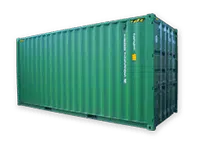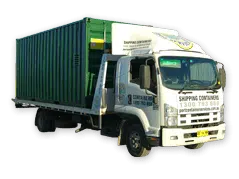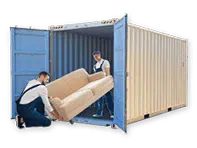Shipping containers are popular due to their many uses. They are secure, robust, and can be stacked on top of each other, making them perfect for transport and storage. They can be delivered, moved, and removed as needed, so many people use them for other purposes as well. They’re great for farms to store equipment, offices to store supplies, and can even be used for accommodation or business fronts.
In terms of traditional storage, a shipping container is relatively cheap. This is a mobile and cost effective alternative to other ways of purchasing additional space. And, if you have goods to transport, buying or hiring a container is the number one solution.
Which shipping container you should get will depend on your needs. There are dozens of containers to choose from, and tons of different types. For general storage, all you’ll need is a general purpose container, but if you have chilled goods, you may need a refrigerated container.There are many other options, including modifications.
You can store a shipping container at your site or on your property if desired. Otherwise, there are container yards that will store them for you. They can be secured with a padlock, or a lockbox can be installed for extra security.
Dimensions refer to the length and height of a container, as well as the dimensions of its doors. There are inside dimensions and outside dimensions, normally done in feet, as well as standard millimetre dimensions.
Malcolm Purcell McClean, aNorth American businessman, developed the modern shipping container. As a transport entrepreneur, he revolutionized trade since the 50s.
Shipping containers were invented to transport goods by sea. Their invention made the process of shipping easier, and prevented the damage that often occurred enroute.
A shipping container is made from 3mm marine-grade steel, folded in such a way that it can’t be crushed, while the structure is much thicker steel. The big double doors that open to 270 degrees are marine-grade plywood.
Our shipping containers come to our ports from China. Many of our competitors have their modifications done in China as well, whereas Shipping Containers Australia do all modification ourselves on Australian soil.
From a large roll of steel, shipping containers are cut, primed, corrugated and welded in a Chinese factory. They are constructed to be strong enough to stack several units on top of each other.
The cost of a shipping container will depend on the market, and what the current demand is like. Prices will also depend on grade, whether they are used, refurbished or brand new. For the current price on a shipping container including delivery to your site please contact us.
Shipping containers are stacked on top of each other, and have corner casts for this purpose which align for stability. There are also twist-locks to secure them in place, but 3 can be stacked without requiring these locks. With locks, up to 7 containers can be stacked safely.
Because shipping containers are made of steel, they will become conductors if hit by lightning. However, if a container is grounded, the shell will act as a Faraday shield and the electricity will be conducted around the outside without affecting its contents.
Without being locked down, or filled with heavy goods, a shipping container may tip over if exposed topowerful winds. When secured with the appropriate twist-locks, a container will remain in place.
If a shipping container is stored and locked in properly, it should withstand a tornado. However, in the event of a strong tornado, it is not advised to take shelter in a free-standing container.
The floor of a shipping container is marine-grade plywood, while the outside structure is marine-grade steel. This means that in the event of a fire, the integrity of the structure will be ok, but interior damage can be expected.
No – a shipping container home is not inherently fireproof. If you are concerned about the possibility of fire damage to your container, you will need to have it fireproofed.
Whether a shipping container home can withstand a hurricane depends on both the storm’s severity and the home’s design. To be cyclone-rated for certain areas, a container home will need to be secured to the ground with industrial-grade twist-locks.
A shipping container home is as safe as its design. A standard general use container will not provide the security of a brick house, but with the right modifications, it can be made into a safe, comfortable living space.
Turning shipping containers into homes is currently a trend. One reason for their appeal is environmental, as it’s a form of recycling, while other reasons might include the speed of manufacture, ease of delivery, or aesthetic appeal.
A mobile home is purposefully built to be lived in, and does not need to be converted. A shipping container home does not need to be registered, but requires significant modification.
A shipping container house is not necessarily cheap. It is possible to make a cheap container home, but it will not be secure or comfortable without the appropriate modifications.
The cost of a shipping container home will depend on the number of containers involved and the extent of modifications. A single converted container may cost in the range of $25,000, but multi-container homes can cost anywhere up to $1,000,000.
If you have land and your council approves a development application involving shipping containers, you can place them anywhere. The containers will have to be level, which helps with modifications, and we can engineer containers according to council allowances.
If you are willing to build a basement and ensure the structural integrity is good enough to support a 2 ton container, it is possible to have a basement beneath a shipping container home.
There are pros and cons to shipping container homes. Some of the cons involve height and floor space restrictions – modifications will improve your comfort level, but the costs per square meter can add up. They need to be dead level, so there are also placement restrictions, and unlike brick homes, container homes are subject to rust.
Shipping container architecture, or “cargo-tecture” as it’s sometimes called, is the conversion of shipping containers into homes, offices, restaurants, or even temporary locations for emergencies.
Some shipping container homes, such as accommodation units with joining kits, can be easily disassembled and moved from site to site. However, full-fledged container homes may be harder to separate. If it is built to be a portal, then it can be moved, but it depends on how it’s built.
A transporter with the appropriate equipment can move a shipping container. If your container is empty, or is full and has fork pockets, a transporter may use a tilt tray to pull it up, or even lift it over fences with a crane.
There are other methods of moving a shipping container without using a crane, such as side loaders and tilt trays, but if you don’t have the specialised equipment, it might be best to call a professional.
How a shipping container is unloaded will depend on the type of transport that was used. We have unloading guides available.
The doors can be taken off of a standard container, and the top can be taken off of an open top container, but generally, no other parts of a shipping container can be dismantled unless modifications enable it.
In terms of comfort, a concrete house would not need as many modifications as a shipping container. They would both need to be insulated, but a container would be cooler at night without insulation.
For parking your car, a shipping container is not as comfortable as a garage. At 2.4m wide, they are great for transporting cars, but not for getting into and out of them with ease. You could cut a side wall out, but we don’t recommend it.
Because they’re designed for security, a shipping container is more durable than a shed. It’s also safer for your possessions. Their double doors open wide, and you can get side-opening containers for more access. While a shed needs to be built on a concrete surface, a container is ready for immediate use as soon as it’s delivered, and can be modified however you like.
Yes – over time, a shipping container’s surface will rust, especially if it is near the ocean. This won’t affect the contents though, and if you maintain it well you can forestall weather damage.
Yes – if a shipping container is underground, any moisture in the surrounding earth will cause its surface to rust over time.
If you intend to bury a shipping container, there are modifications that must be made first, such as reinforcing the walls so they don’t warp under pressure. There is also the risk of rust from moisture in the ground.
No – a shipping container will sink. If dropped in the ocean, they may wash ashore.
If treated with a water-proofing membrane, a shipping container will hold water, and can even be used as a swimming pool. Typically, Polyurea is used for this purpose.
Here at Shipping Containers Australia, we don’t specialise in creating swimming pools. We can provide the ideal container for your needs, but to have it converted into a pool you will need to contact a company who specialises.
Because it is a big steel box, there is a high chance of rust when shipping containers are converted into swimming pools. Issues like this, or problems with the pump work, can be difficult to treat with in-ground pools. A better alternative might be an above-ground pool with a deck, and a hatch to go below.
Above-ground pools can be cheaper when shipping containers are used, but in-ground pools may present issues that require more expensive maintenance.
Occasionally, shipping containers may contain chemical residue from previous use, but this depends on what they were used for. Their plywood floors can be unscrewed and new panels can be added if there is any suspicion of toxicity.
You can buy replacement parts for a shipping container, such as new flooring and panels to screw in. What’s available will depend on the size of your container, and its modifications.
The PPSR, or Personal Property Securities Register, will track your shipping container. You can register your containers there and it shows you the ownership.







